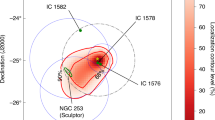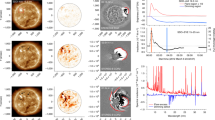Abstract
Coronal mass ejections (CMEs), often associated with flares1,2,3, are the most powerful magnetic phenomena occurring on the Sun. Stars show magnetic activity levels up to ten thousand times higher4, and CME effects on stellar physics and circumstellar environments are predicted to be substantial5,6,7,8,9. However, stellar CMEs remain observationally unexplored. Using time-resolved high-resolution X-ray spectroscopy of a stellar flare on the active star HR 9024 observed with the High Energy Transmission Grating Spectrometer onboard the Chandra X-ray Observatory space telescope, we distinctly detected Doppler shifts in S xvi, Si xiv and Mg xii lines that indicate upward and downward motions of hot plasmas (around 10–25 MK) within the flaring loop, with velocities of 100–400 km s−1, in agreement with a model of a flaring magnetic tube. Most notably, we also detected a later blueshift in the O viii line that reveals an upward motion, with velocity 90 ± 30 km s−1, of cool plasma (about 4 MK), that we ascribe to a CME coupled to the flare. From this evidence we were able to derive a CME mass of \(1\!.\!2_{ - 0.8}^{ + 2.6} \times 10^{21}\) g and a CME kinetic energy of \(5\!.\!2_{ - 3.6}^{ + 27.7} \times 10^{34}\) erg. These values provide clues in the extrapolation of the solar case to higher activity levels in other stars, suggesting that CMEs could indeed be a major cause of mass and angular momentum loss.
This is a preview of subscription content, access via your institution
Access options
Access Nature and 54 other Nature Portfolio journals
Get Nature+, our best-value online-access subscription
$29.99 / 30 days
cancel any time
Subscribe to this journal
Receive 12 digital issues and online access to articles
$119.00 per year
only $9.92 per issue
Buy this article
- Purchase on Springer Link
- Instant access to full article PDF
Prices may be subject to local taxes which are calculated during checkout




Similar content being viewed by others
Data availability
The Chandra dataset analysed in this work (ObsID 1892) can be accessed from http://cxc.harvard.edu/. The data that support plots and findings of this study are available from the corresponding author upon reasonable request.
References
Yashiro, S. & Gopalswamy, N. Statistical relationship between solar flares and coronal mass ejections. In Universal Heliophysical Processes (eds Gopalswamy, N. & Webb, D. F.) Vol. 257, 233–243 (IAU Symp., 2009).
Aarnio, A. N., Stassun, K. G., Hughes, W. J. & McGregor, S. L. Solar flares and coronal mass ejections: a statistically determined flare flux−CME mass correlation. Sol. Phys. 268, 195–212 (2011).
Webb, D. F. & Howard, T. A. Coronal mass ejections: observations. Living Rev. Sol. Phys. 9, 3 (2012).
Wright, N. J., Drake, J. J., Mamajek, E. E. & Henry, G. W. The stellar-activity−rotation relationship and the evolution of stellar dynamos. Astrophys. J. 743, 48 (2011).
Khodachenko, M. L. et al. Coronal mass ejection (CME) activity of low mass M stars as an important factor for the habitability of terrestrial exoplanets. I. CME impact on expected magnetospheres of Earth-like exoplanets in close-in habitable zones. Astrobiology 7, 167–184 (2007).
Aarnio, A. N., Matt, S. P. & Stassun, K. G. Mass loss in pre-main-sequence stars via coronal mass ejections and implications for angular momentum loss. Astrophys. J. 760, 9 (2012).
Drake, J. J., Cohen, O., Yashiro, S. & Gopalswamy, N. Implications of mass and energy loss due to coronal mass ejections on magnetically active stars. Astrophys. J. 764, 170 (2013).
Osten, R. A. & Wolk, S. J. Connecting flares and transient mass-loss events in magnetically active stars. Astrophys. J. 809, 79 (2015).
Odert, P., Leitzinger, M., Hanslmeier, A. & Lammer, H. Stellar coronal mass ejections. I. Estimating occurrence frequencies and mass-loss rates. Mon. Not. R. Astron. Soc. 472, 876–890 (2017).
Noyes, R. W., Hartmann, L. W., Baliunas, S. L., Duncan, D. K. & Vaughan, A. H. Rotation, convection, and magnetic activity in lower main-sequence stars. Astrophys. J. 279, 763–777 (1984).
Shibata, K. & Magara, T. Solar flares: magnetohydrodynamic processes. Living Rev. Sol. Phys. 8, 6 (2011).
Güdel, M. X-ray astronomy of stellar coronae. Annu. Rev. Astron. Astrophys. 12, 71–237 (2004).
Houdebine, E. R., Foing, B. H. & Rodono, M. Dynamics of flares on late-type dMe stars. I. Flare mass ejections and stellar evolution. Astron. Astrophys. 238, 249–255 (1990).
Vida, K. et al. Investigating magnetic activity in very stable stellar magnetic fields. Long-term photometric and spectroscopic study of the fully convective M4 dwarf V374 Pegasi. Astron. Astrophys. 590, A11 (2016).
Vida, K. et al. The quest for stellar coronal mass ejections in late-type stars. I. Investigating Balmer-line asymmetries of single stars in virtual observatory data. Astron. Astrophys. 623, A49 (2019).
Gunn, A. G., Doyle, J. G., Mathioudakis, M., Houdebine, E. R. & Avgoloupis, S. High-velocity evaporation during a flare on AT Microscopii. Astron. Astrophys. 285, 489–496 (1994).
Berdyugina, S. V., Ilyin, I. & Tuominen, I. The active RS Canum Venaticorum binary II Pegasi. III. Chromospheric emission and flares in 1994–1996. Astron. Astrophys. 349, 863–872 (1999).
Moschou, S.-P., Drake, J. J., Cohen, O., Alvarado-Gomez, J. D. & Garraffo, C. A monster CME obscuring a demon star flare. Astrophys. J. 850, 191 (2017).
Wheatley, P. J. ROSAT observations of V471 Tauri, showing that stellar activity is determined by rotation, not age. Mon. Not. R. Astron. Soc. 297, 1145–1150 (1998).
Mullan, D. J., Sion, E. M., Bruhweiler, F. C. & Carpenter, K. G. Evidence for a cool wind from the K2 dwarf in the detached binary V471 Tauri. Astrophys. J. Lett. 339, L33–L36 (1989).
Testa, P., Reale, F., Garcia-Alvarez, D. & Huenemoerder, D. P. Detailed diagnostics of an X-ray flare in the single giant HR 9024. Astrophys. J. 663, 1232–1243 (2007).
Borisova, A. et al. The different origins of magnetic fields and activity in the Hertzsprung gap stars, OU Andromedae and 31 Comae. Astron. Astrophys. 591, A57 (2016).
Strassmeier, K. G., Serkowitsch, E. & Granzer, T. Starspot photometry with robotic telescopes, UBV(RI)C and by light curves of 47 active stars in 1996/97. Astron. Astrophys. Suppl. Ser. 140, 29–53 (1999).
Pizzolato, N., Maggio, A. & Sciortino, S. Evolution of X-ray activity of 1–3 Msun late-type stars in early post-main-sequence phases. Astron. Astrophys. 361, 614–628 (2000).
Testa, P. et al. Geometry diagnostics of a stellar flare from fluorescent X-rays. Astrophys. J. 675, L97 (2008).
Švestka, Z. Speeds of rising post-flare structures. Sol. Phys. 169, 403–413 (1996).
West, M. J. & Seaton, D. B. SWAP observations of post-flare giant arches in the long-duration 14 October 2014 solar eruption. Astrophys. J. Lett. 801, L6 (2015).
Landi, E., Raymond, J. C., Miralles, M. P. & Hara, H. Physical conditions in a coronal mass ejection from hinode, stereo, and SOHO observations. Astrophys. J. 711, 75–98 (2010).
Drake, J. J., Cohen, O., Garraffo, C. & Kashyap, V. Stellar flares and the dark energy of CMEs. In Solar and Stellar Flares and their Effects on Planets (eds. Kosovichev, A. G., Hawley, S. L. & Heinzel, P.) Vol. 320, 196–201 (IAU Symp., 2016).
Alvarado-Gómez, J. D., Drake, J. J., Cohen, O., Moschou, S. P. & Garraffo, C. Suppression of coronal mass ejections in active stars by an overlying large-scale magnetic field: a numerical study. Astrophys. J. 862, 93 (2018).
Huenemoerder, D. P. et al. TGCat: the Chandra transmission grating data catalog and archive. Astron. J. 141, 129 (2011).
Argiroffi, C. et al. Redshifted X-rays from the material accreting onto TW Hydrae: evidence of a low-latitude accretion spot. Astron. Astrophys. 607, A14 (2017).
Brickhouse, N. S., Dupree, A. K. & Young, P. R. X-ray Doppler imaging of 44i Bootis with Chandra. Astrophys. J. 562, L75–L78 (2001).
Chung, S. M., Drake, J. J., Kashyap, V. L., Lin, L. W. & Ratzlaff, P. W. Doppler shifts and broadening and the structure of the X-ray emission from Algol. Astrophys. J. 606, 1184–1195 (2004).
Ishibashi, K., Dewey, D., Huenemoerder, D. P. & Testa, P. Chandra/HETGS observations of the Capella system: the primary as a dominating X-ray source. Astrophys. J. 644, L117–L120 (2006).
Smith, R. K., Brickhouse, N. S., Liedahl, D. A. & Raymond, J. C. Collisional plasma models with APEC/APED: emission-line diagnostics of hydrogen-like and helium-like ions. Astrophys. J. 556, L91–L95 (2001).
Singh, K. P., Drake, S. A., White, N. E. & Simon, T. ROSAT observations of five chromospherically active stars. Astron. J. 112, 221 (1996).
Cheng, X., Zhang, J., Saar, S. H. & Ding, M. D. Differential emission measure analysis of multiple structural components of coronal mass ejections in the inner corona. Astrophys. J. 761, 62 (2012).
Landi, E., Miralles, M. P., Raymond, J. C. & Hara, H. Hot plasma associated with a coronal mass ejection. Astrophys. J. 778, 29 (2013).
Acknowledgements
We acknowledge a modest financial contribution from the ASI-INAF agreement n.2017-14.H.O.
Author information
Authors and Affiliations
Contributions
C.A., F.R., J.J.D., A.C., P.T., R.B., M.M., S.O. and G.P. contributed to scientific discussion and writing of the text. C.A. and J.J.D. contributed to analysis of observational data. F.R. contributed to the hydrodynamic model development, and C.A. to the synthesis of the model line profile.
Corresponding author
Ethics declarations
Competing interests
The authors declare no competing interests.
Additional information
Peer review information: Nature Astronomy thanks Krisztian Vida and the other, anonymous, reviewer(s) for their contribution to the peer review of this work.
Publisher’s note: Springer Nature remains neutral with regard to jurisdictional claims in published maps and institutional affiliations.
Supplementary information
Supplementary Information
Supplementary Figures 1–2, Supplementary Tables 1–2.
Rights and permissions
About this article
Cite this article
Argiroffi, C., Reale, F., Drake, J.J. et al. A stellar flare−coronal mass ejection event revealed by X-ray plasma motions. Nat Astron 3, 742–748 (2019). https://doi.org/10.1038/s41550-019-0781-4
Received:
Accepted:
Published:
Issue Date:
DOI: https://doi.org/10.1038/s41550-019-0781-4
This article is cited by
-
X-ray detection of astrospheres around three main-sequence stars and their mass-loss rates
Nature Astronomy (2024)
-
Stellar flares
Living Reviews in Solar Physics (2024)
-
Extreme Solar Events: Setting up a Paradigm
Space Science Reviews (2023)
-
Extreme solar events
Living Reviews in Solar Physics (2022)



